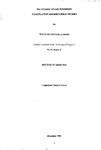POLYCYSTIC OVARY SYNDROME COAGULATION AND METABOLIC STUDIES
| dc.contributor.author | ATIOMO, WILLIAM USINODE | |
| dc.contributor.other | Peninsula Medical School | en_US |
| dc.date.accessioned | 2013-11-22T16:04:40Z | |
| dc.date.available | 2013-11-22T16:04:40Z | |
| dc.date.issued | 1998 | |
| dc.identifier | NOT AVAILABLE | en_US |
| dc.identifier.uri | http://hdl.handle.net/10026.1/2828 | |
| dc.description.abstract |
The polycystic ovary syndrome (PCOS) is a heterogeneous disorder in women characterised by chronic ovulatory failure, hyperandrogenaemia, and insulin resistance. Some women are completely asymptomatic and others present with extreme menstrual disturbance, severe hirsutism, infertility and recurrent miscarriage. The pathophysiology of PCOS is not completely understood, but it is thought that insulin resistance plays a central role. In normal subjects, non-diabetic obese patients and patients with non-insulin dependent diabetes, insulin resistance is associated with elevated plasminogen activator inhibitor-1 (PAI-1) levels. PAI-1 is a glycoprotein, which inhibits the formation of plasmin (a proteolytic enzyme). Plasmin aids fibrinolysis and extracellular proteolysis. High PAI-1 and low plasmin levels increase the risk of thrombosis and impair extracellular proteolysis required in ovarian follicle growth, ovulation and embryo implantation. This study was designed to determine whether elevated plasminogen activator inhibitor-1 (PAI-1) was associated with the insulin resistance present in PCOS, investigate its possible role in the causation of anovulation and recurrent pregnancy loss in these women and ascertain whether it was an additional thrombotic risk factor so that clinicians and patients could take appropriate measures to reduce this risk In a pilot study, systemic PAI-1 activity was significantly elevated in oligomenorrhoiec women with PCOS. A larger study supported these findings, but demonstrated that obesity was a significant confounding factor, as the increase in PAI-1activity disappeared when standardised for weight. Activated Protein-C (APC) resistance was subsequently tested in these women because of the unexpected finding of an increased prevalence of a positive family history of thrombosis in women with PCOS compared with controls, but there was no increase in the prevalence of APC-resistance in PCOS. In another project, the cellular distribution of PAI-1 protein in human ovaries was described for the first time using immunohistochemistry. It was localised to the granulosa and theca cell compartments in both polycystic and normal ovaries, however there was no significant difference in the intensity of PAI-l staining between both groups on image analysis. PAI-1 messenger RNA expression was also evaluated in these biopsies by in-situ hybridisation, but no signal was detected suggesting that there was either a low overall RNA preservation in the tissues, or an insufficient sensitivity of the cocktail of oligonucleotide probes used. This study did not support the hypothesis that elevated PAI-1 was a feature of PCOS, however the in-situ location of PAI-1 protein was demonstrated for the first time in the human ovary and consistent with a previously suspected role in ovulation. The results did not support a role for PAI-1 in anovulation, recurrent miscarriage or increased thrombosis in PCOS. | en_US |
| dc.language.iso | en | en_US |
| dc.publisher | University of Plymouth | en_US |
| dc.title | POLYCYSTIC OVARY SYNDROME COAGULATION AND METABOLIC STUDIES | en_US |
| dc.type | Thesis | en_US |
| plymouth.version | Full version | en_US |
| dc.identifier.doi | http://dx.doi.org/10.24382/1310 | |
| dc.identifier.doi | http://dx.doi.org/10.24382/1310 |
Files in this item
This item appears in the following Collection(s)
-
01 Research Theses Main Collection
Research Theses Main


